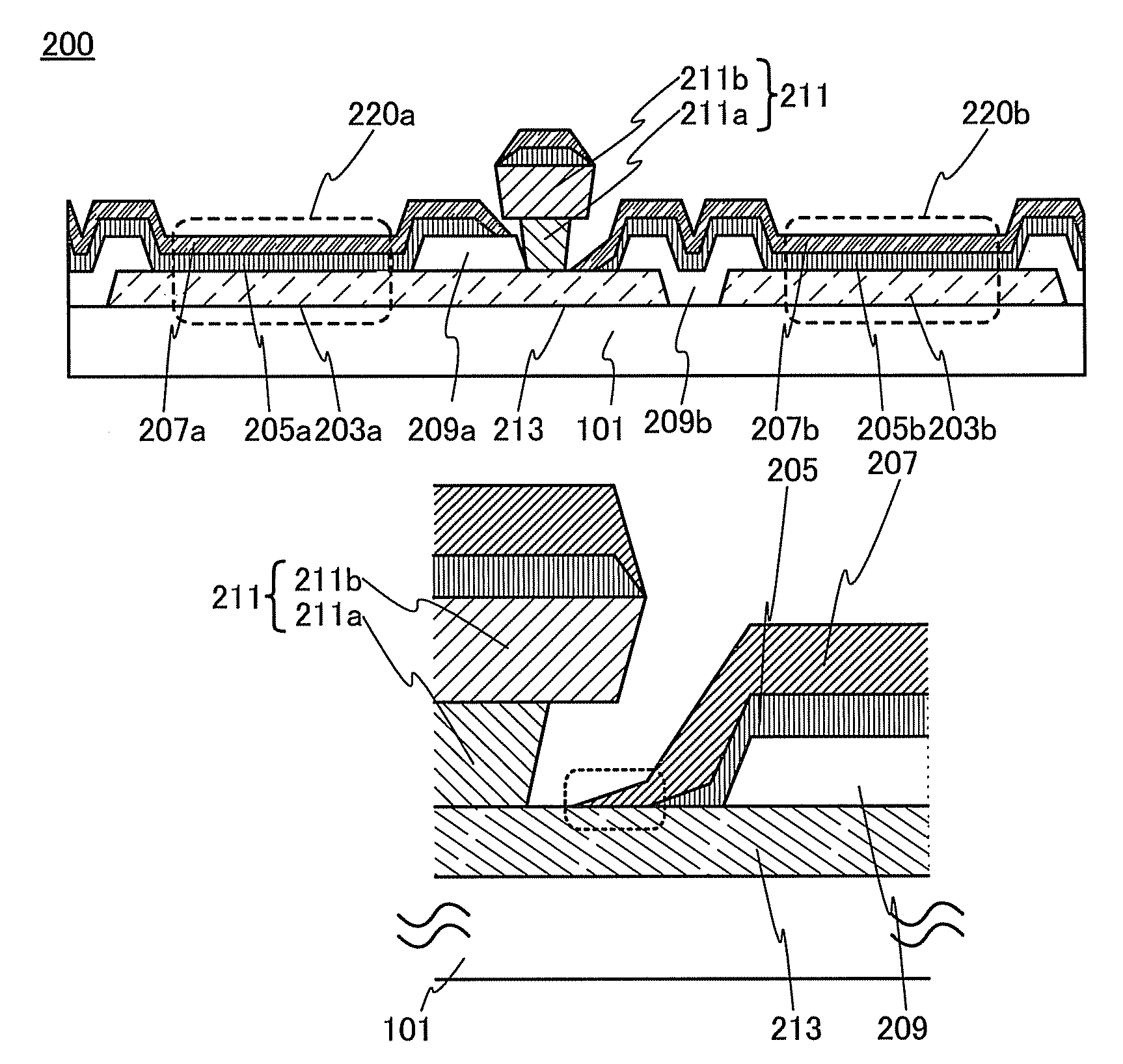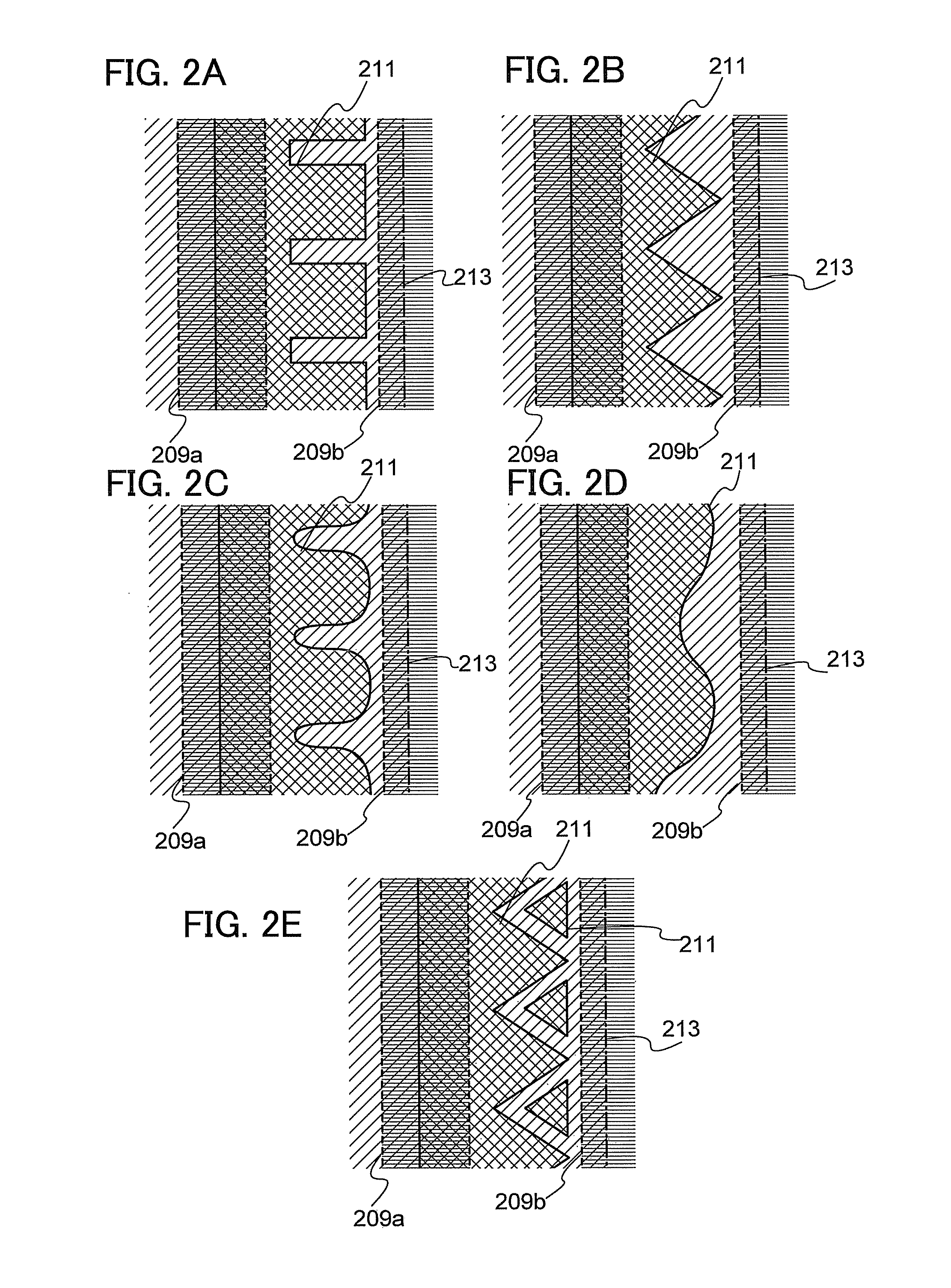Light-emitting device and lighting device
a technology of light-emitting devices and lighting devices, which is applied in the direction of discharge tubes/lamp details, organic semiconductor devices, discharge tubes/lamp details, etc., can solve the problems of high manufacturing yield, small light-emitting region of devices manufactured using metal masks, and difficult to use photolithography techniques utilizing solvents. , to achieve the effect of high reliability, high manufacturing yield and high reliability
- Summary
- Abstract
- Description
- Claims
- Application Information
AI Technical Summary
Benefits of technology
Problems solved by technology
Method used
Image
Examples
embodiment 1
(Embodiment 1)
[0058]FIGS. 1A and 1B are schematic cross-sectional views of a light-emitting device according to an embodiment of the present invention. Note that here, part of the light-emitting device according to an embodiment of the present invention is illustrated. FIG. 1A is a schematic cross-sectional view of a light-emitting device 200 including an EL element. In the light-emitting device 200, a first electrode 203, an EL layer 205, and a second electrode 207 are provided in this order over the substrate 101 having an insulating surface, and a portion where these components are in contact with one another is a light-emitting region 220 of the EL element.
[0059]In this specification, it has already been stated that in the case where a plurality of light-emitting regions is provided, the light-emitting regions which include electrodes having the same potential are considered to be in one EL element even in the case where the light-emitting regions are separated. In contrast, whe...
embodiment 2
(Embodiment 2)
[0084]FIG. 4 is a cross-sectional view of a light-emitting device according to an embodiment of the present invention, which is different from that in Embodiment 1. Note that FIG. 4 illustrates part of the light-emitting device according to an embodiment of the present invention. As in the light-emitting device in FIGS. 1A and 1B, in the light-emitting device in FIG. 4, a first electrode 303, an EL layer 305, and a second electrode 307 are provided in this order over the substrate 101 having an insulating surface, and a portion where these components are in contact with one another is a light-emitting region 320 of an EL element. In the EL element, an electrode layer on the side from which light is extracted is formed using a material which transmits light from the EL layer. For example, a light-transmitting conductive material is used for the second electrode 307 in the case of a top-emission type, for the first electrode 303 in the case of a bottom-emission type, or ...
embodiment 3
(Embodiment 3)
[0102]FIG. 6 is a schematic top view of a light-emitting device 300 according to an embodiment of the present invention, in which the structure in Embodiment 1 and the structure in Embodiment 2 are combined.
[0103]The light-emitting device 300 includes four EL elements (a first EL element a, a second EL element b, a third EL element c, and a fourth EL element d) surrounded by the separation layer 311. The four EL elements are connected in series by a series connection portion 350a, a series connection portion 350b, a series connection portion 350c, and a series connection portion 350d. Since the structure of the series connection portions is described in Embodiment 1, the description is omitted here. The description in Embodiment 1 is to be referred to. A cross-sectional view taken along line A-A′ in FIG. 6 corresponds to the cross-sectional view in FIG. 1A described in Embodiment 1.
[0104]Note that the EL layer 305, the second electrode 307, and the like are not illustr...
PUM
 Login to View More
Login to View More Abstract
Description
Claims
Application Information
 Login to View More
Login to View More - R&D
- Intellectual Property
- Life Sciences
- Materials
- Tech Scout
- Unparalleled Data Quality
- Higher Quality Content
- 60% Fewer Hallucinations
Browse by: Latest US Patents, China's latest patents, Technical Efficacy Thesaurus, Application Domain, Technology Topic, Popular Technical Reports.
© 2025 PatSnap. All rights reserved.Legal|Privacy policy|Modern Slavery Act Transparency Statement|Sitemap|About US| Contact US: help@patsnap.com



